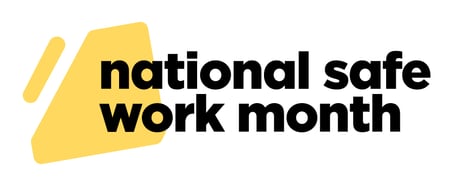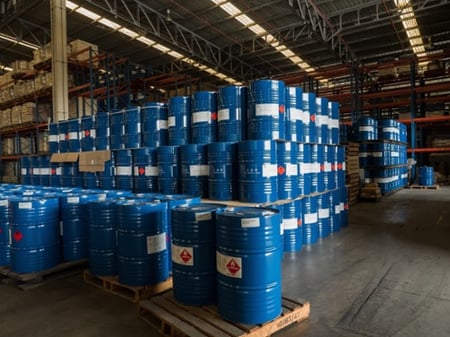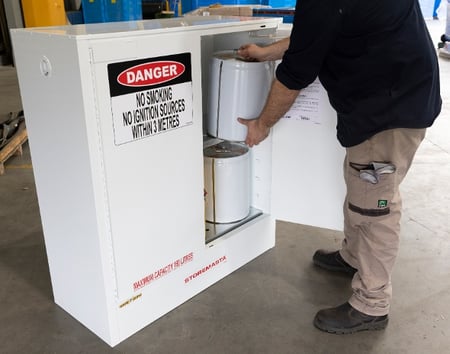We’re getting into the spirit of National Safe Work Month with a post dedicated to raising awareness about the invaluable online resources that can help you improve hazardous chemical safety. These essential resources can help any business of any size implement measures to improve work health and safety – and decrease the risk of fatalities, accidents and illness.
IMPORTANT: Work-related fatalities, injuries and illnesses not only impact staff, but also their families and community. These incidents cause physical, mental and emotional distress. In Australia, every worker has the right to work in safe and healthy environment.
What Is National Work Safe Month?
National Safe Work Month #safeworkmonth is a campaign created by Safe Work Australia to help build safe and healthy workplaces for all Australians.
The theme for Safe Work Month 2025 is:
Safety: every job, every day
National Safe Work Months build awareness about the ways in which Safe Work Australia can assist workplaces in improving work health and safety in their daily operations. In 2025, Safe Work Month focuses on a different topic each week, including identifying hazards, assessing risks, controlling risks, and reviewing controls.
Businesses and organisations can get involved in National Safe Work Month by using it as an opportunity to promote better practices in their own workplace.

It’s also a good opportunity to tap into the vast range of free online resources that Safe Work Australia offers. From the specific WHS laws in your state or territory to Codes of Practice for work activities, this information is available 24/7 as free resources and tools via the SWA website.
How Does Safe Work Australia Help Businesses?
Safe Work Australia is an Australian government statutory agency that focuses on health and safety issues in the workplace. The agency helps create safer, healthier and more productive workplaces by improving work health and safety conditions, as well as workers’ compensation arrangements.
Safe Work Australia develops policies to specifically reduce the incidence of:
- Work-related death
- Injury
- Illness
- Exposure to hazards and risks in the workplace
Key responsibilities of Safe Work Australia include:
- undertaking research
- collecting, analysing and reporting data
- the development and evaluation of national WHS and workers’ compensation policy and strategies
- the development and evaluation of the model WHS legislative framework
DID YOU KNOW: The highest workers' compensation claim rate is for staff aged 60-64 years of age? The lowest claim rate is for staff aged 35-39 years.
Hazardous Chemical Safety: Key Resources to Access
Responsible for the development of national policy relating to work health and safety and workers’ compensation, Safe Work Australia also provides a huge wealth of resources including data, research, Codes of Practice and other information to reduce hazards.

Access a wide range of free resources to improve your organisation’s hazardous chemical management.
While our team at Storemasta regularly refer to Safe Work Australia’s resources on hazardous chemicals and dangerous goods safety, their advice covers a broad range of topics for all types of industries and businesses.
However, keep in mind that Safe Work Australia is not a regulator. Therefore, they can’t advise you about WHS issues in the workplace. If you do need to speak with someone regarding work health and safety, you should get in touch with the authority in your state or territory.
Developing the correct chemical handling and storage practices is essential for compliance and safety.
The regulatory authorities within Australia are listed below in alphabetical order in relation to their location:
- Northern Territory – NT WorkSafe
- Australian Capital Territory – WorkSafe ACT
- New South Wales – SafeWork NSW
- Queensland – WorkSafe QLD
- South Australia – SafeWork SA
- Tasmania – WorkSafe Tasmania
- Victoria – WorkSafe Victoria
- Western Australia – WorkSafe Department of Mines, Industry Regulation and Safety
REMEMBER: Handling and storing your hazardous chemicals in a compliant manner is part of your WHS obligations. Storemasta manufacture a range of chemical storage solutions that are 100% compliant and proudly made in Tasmania.
How Do You Access Safe Work Australia Resources?
The great thing about Safe Work Australia is they make it very easy to gain a deeper understanding about hazards in the workplace – and ways in which you can improve safety.
There are a multitude of different online resources which can assist you in building a better workplace health and safety strategy within your own operations. We’ll go into detail about some of the resources that are available for businesses just like yours.
Model Codes of Practice
Codes of Practice give detailed guidance for workplaces dealing with hazardous situations. Safe Work Australia offers a wide range of resources for topics including working in confined spaces, first aid in the workplace, how to safely remove asbestos and many other Codes of Practice.
For businesses dealing with chemical management in their operations, there are some particularly useful Codes of Practices that you can access for free online, including:
- Hazardous manual tasks
- How to manage work health and safety risks
- Labelling of workplace hazardous chemicals
- Managing risks of hazardous chemicals in the workplace
- Managing the work environment and facilities
- Preparation of safety data sheets for hazardous chemicals
- Spray painting and powder coating
- Welding processes
Chemicals and Hazards
Their website also has a useful tool for any organisation that carries hazardous substances. Within the hazard section of the site, you can Search Hazardous Chemicals through a range of identifiers such as the chemical’s name, CAS number, hazard category, source code and more.
While some hazardous chemicals may not be listed within this online resource, it’s a helpful, quick and easy way to find out more about the hazards associated with your onsite substances.
The workplace exposure standards for airborne contaminants details the legal limits applicable for workplaces that carry specific chemical products. To learn more about the exposure standards that apply to your oragnisation, you can also use the additional tool to Search Exposure Standards and access details about your exposure limits.
Resources
If you access the resources and publications section of Safe Work Australia’s website, you can search for specific documents such as guidance materials and legislation information. You can also narrow your search by clicking on Hazardous Chemicals within category to pull up all relevant resources, or you may search by industry or a specific topic.

You can search for information about your chemical products using the online Safe Work Australia tool.
For example, many of our customers are involved with agricultural enterprises. And these types of workplaces often handle dangerous goods such as toxic substances and flammable liquids. Safe Work Australia has developed a convenient tool for the agricultural industry to access information about their duties under WHS laws.
IMPORTANT: 169 people were killed on the job in Australia in 2021, with vehicle collisions and moving objects being the cause for the highest percentage of fatalities. Ensuring staff are properly trained and equipped to do their job is an essential part of workplace health and safety.
WHS Laws in your Jurisdiction
While the model WHS laws provide regulations that may be implemented by the individual states and territories, it’s important to understand what the WHS laws are in your jurisdiction. There may be substantial variations between the WHS laws of states and territories, so you must always review and understand the WHS laws that apply to your state or territory.
The Safe Work Australia website details the regulators in each jurisdiction, as well as the laws and contacts for that state or territory. This is a particularly useful tool if you have operations across several states or territories of Australia.
Your regulator will be responsible for a range of tasks including:
- Monitoring and enforcing compliance with WHS laws
- Offering advice and information on WHS duties
- Collecting, analysing and publishing statistics
- Supporting education and training
- Consulting and coordinating with duty holders, workers and representatives on WHS issues
IMPORTANT: If you’re a small business owner in NSW, you could access a $1,000 rebate to assist with the purchase of safety items. Administered by SafeWork NSW, this program offers grants to businesses so they can improve work health and safety for their team. Read more about the program here.
Work Safer and Smarter with Hazardous Chemicals
Whether you’re a spray painter, a farmer or you’re running a manufacturing enterprise, improving your knowledge about work health and safety issues is key if you’re serious about improving conditions at your site. We encourage every business that manages hazardous substances to become more familiar with Safe Work Australia’s resources and reach out to your local regulator if you need further advice.
To help you learn more about hazardous chemicals in the workplace, we’ve created a handy eBook. Access your copy for free today to learn more about preventing incidents, such as chemical spillage and vapour emissions, in your own operations through conducting an inhouse risk assessment.
Talarah has been working for Storemasta for many years, specialising in Marketing, Customer Service and Risk Management Solutions.

